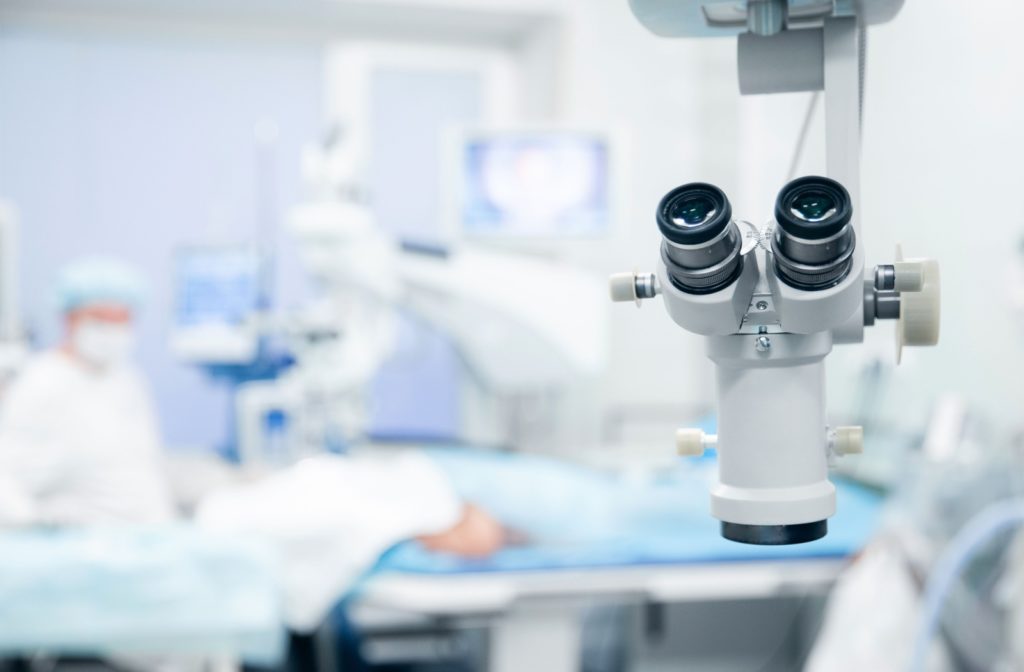Nearsightedness, also known as myopia, is a common vision condition. If you’ve experienced difficulties seeing distant objects clearly while up-close tasks remain sharp, you’re already familiar with the challenges of nearsightedness.
This refractive error occurs when the eyeball is too long, or the cornea is too curved, causing light to focus in front of the retina rather than directly on it. Currently, there is no cure for nearsightedness, but blurry vision caused by nearsightedness can be corrected.
Glasses, contact lenses, and laser eye surgery are all options that may be available to people with nearsightedness depending on their age and eye health. If it’s detected early, myopia control can also help kids avoid the progressive worsening of their vision when they have nearsightedness.
Learning more about nearsightedness can help you make the right decisions for your own vision—or the vision of your child if they start to develop myopia.
What Causes Nearsightedness?
For most people, the condition develops during childhood and stabilizes in early adulthood. While genetics play a significant role in its development, environmental factors—like prolonged close-up work or limited outdoor activities—are increasingly considered contributors to its progression.
Unfortunately, once myopia develops, it can’t be cured or reversed. However, modern eye care has significantly advanced in managing and correcting the condition to reduce its impact on your daily life.
Vision Correction Options for Nearsightedness
Treating nearsightedness typically focuses on improving vision clarity rather than eliminating the condition. Here are some of the most common corrective approaches:
Eyeglasses
Eyeglasses are the simplest and most common method for managing myopia. Prescription lenses correct how light focuses on the retina, allowing distant objects to appear sharp and clear.
Contact Lenses
For those who prefer an alternative to glasses, contact lenses offer similar vision correction. Various options cater to individual preferences and needs, including daily, extended wear, and rigid gas-permeable lenses.
Laser Eye Surgery
Laser eye surgery, also known as refractive surgery, is an option for some people who want to reduce their reliance on contact lenses and glasses. Treatments like LASIK (laser-assisted in situ keratomileusis) can offer lasting vision correction—often considered permanent—by reshaping the cornea with laser precision.
It’s crucial to note that while treatments like LASIK can significantly improve vision, they don’t always completely eliminate the need for glasses and contacts. Laser eye surgery also isn’t recommended for children or people who don’t have a stable vision prescription, because the treatment can’t stop your eyes from changing or your vision from getting worse over time—especially due to other refractive errors like presbyopia.

Can Nearsightedness Be Prevented from Worsening?
Nearsightedness tends to get worse over time, especially as children get older and their eyes grow. The progression of nearsightedness can’t be reversed, but it can be slowed, and in some cases stabilized, with methods that control the growth of the eye. These types of treatments are often referred to as myopia control.
Myopia Control Techniques
- Atropine Eye Drops: There’s evidence that shows low-dose atropine drops can reduce the progression of myopia in children. They help prevent elongation by relaxing the eye’s focusing mechanisms.
- Multifocal Contact Lenses: Multifocal contact lenses are designed with multiple different prescriptions in a single lens. The center of the lens provides clear vision, while the very edge defocuses light. This method of peripheral defocusing can signal the eye to stop growing, slowing its continued elongation.
Lifestyle Adjustments
There are some studies that show more outdoor activity and regular breaks from prolonged screen time can play a role in preventing the initial development of myopia. For that reason, it may be helpful to encourage your children to spend more time outdoors to reap the visual benefits of natural light.
Eye Health Matters
Managing nearsightedness is just one part of maintaining your overall eye health, and it’s something that requires consistent care and attention. Regular eye exams are essential for everyone, whether you’re exploring myopia control options for a child or keeping track of your own changing prescription as an adult.
These exams don’t just help with vision correction—they allow eye care professionals to monitor for signs of other potential issues, such as glaucoma, cataracts, or retinal problems. Early detection of these conditions is key to preventing complications and preserving your vision.
Need Help with Blurry Vision?
While nearsightedness cannot yet be cured, it can be corrected and managed. From daily glasses to myopia control methods, numerous solutions are available to help you maintain a sharp and clear view of the world.
If you want personalized support for managing nearsightedness and other vision concerns, Total Vision Bonita can help. Our dedicated team offers comprehensive eye exams, myopia control strategies, and tailored treatments to suit your needs.Your eye health is our priority—book an appointment today and take a step toward clear vision.


